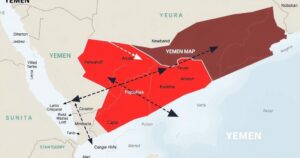Understanding the U.S. Military Operation Against Yemen’s Houthis

The U.S. has commenced a military operation against Yemen’s Houthis due to their attacks on Red Sea shipping, resulting in numerous casualties. President Trump has warned Iran to cease its support for the Houthis or face consequences. The Houthis have vowed to retaliate against U.S. vessels while the Houthi leader claims their actions are aimed at supporting Palestine. Historical contexts, including the Houthis’ origins, their previous maritime actions, and international concerns about trade disruptions, shape the current conflict.
The United States has initiated a significant military operation against Yemen’s Iran-aligned Houthis, following their attacks on shipping in the Red Sea, which resulted in the death of at least 53 individuals. This operation, occurring under President Donald Trump’s administration, is expected to extend for several weeks. Initial reports indicate that among those killed were five children and two women, with 98 others injured according to the Houthi ministry of health.
In a response to the escalating conflict, President Trump issued a stern warning to Iran, the Houthis’ principal ally, demanding an immediate cessation of support. He emphasized that if Iran posed a threat to the United States, it would face severe consequences: “America will hold you fully accountable and, we won’t be nice about it!” Meanwhile, Houthi leader Abdul Malik al-Houthi threatened to target U.S. vessels in the Red Sea if American attacks on Yemen persisted, stating, “If they continue their aggression, we will continue the escalation.”
The Houthis, a Shiite rebel group, have maintained significant control in Yemen since taking the capital, Sana’a, in 2014. Their origins trace back to the late 1990s, where the family established a religious revival movement amidst socio-economic disenfranchisement. Professor Sarah Phillips from the University of Sydney remarked that the Houthis derive their legitimacy by portraying themselves as defenders of Palestine and adversaries to U.S. influence in the region.
Historically, the Houthis have engaged in actions related to the Gaza conflict, launching attacks on shipping routes in a display of solidarity with Palestinians. These maritime assaults have disrupted global trade, leading shipping companies to reroute their vessels. Although the Houthis claim to target only those vessels associated with Israel, U.S. and British interests are also at risk, prompting retaliatory airstrikes aimed at safeguarding international shipping lanes.
Following a temporary calm alongside a ceasefire in January, the Houthis reaffirmed their intentions to resume naval operations in March. In light of these developments, President Trump ordered airstrikes against Houthi-held regions to ensure navigational safety for American vessels, asserting a commitment to using “overwhelming lethal force” until aggressions ceased.
Iranian military leaders indicated that the Houthis operate independently, cautioning that any U.S. escalation could provoke a significant Iranian response. Dr. Sarah Phillips noted that the Houthis have a long-standing history of resilience and adaptability, suggesting that the U.S. strategy may not yield the desired results. As the conflict escalates, U.N. Secretary-General António Guterres urged restraint to avert further humanitarian crises in Yemen and the surrounding regions.
The U.S. military operation against Yemen’s Houthis marks a critical escalation in regional tensions, primarily driven by the militia’s maritime attacks linked to broader geopolitical dynamics. The historical context of the Houthis, their ideological claims, and external support underscore the complexity of the conflict. The potential for continued escalation raises significant humanitarian concerns, necessitating international calls for restraint and dialogue. Ultimately, the unfolding situation remains precarious, with implications for regional stability and global trade.
Original Source: www.abc.net.au








